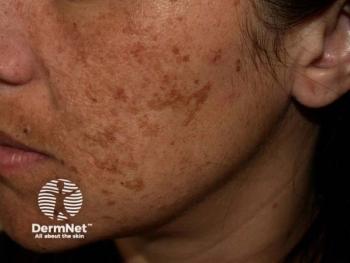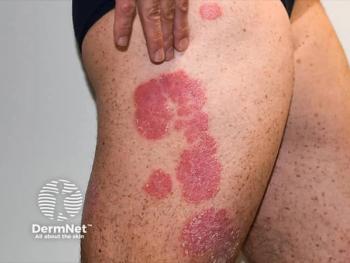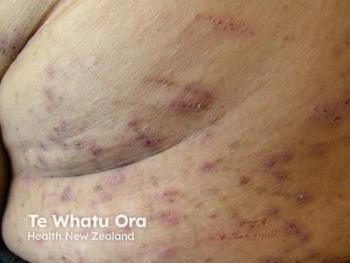
- Dermatology Times, Managing Psoriasis With Biologics in the Medicare-Aged Patient Population, October 2025 (Vol. 46. Supp. 06)
- Volume 46
- Issue 06
Tailoring Biologic Options in Medicare-Aged Patients With Plaque Psoriasis
Key Takeaways
- In-office administered biologics like tildrakizumab are prioritized for patients with cognitive impairment and metabolic syndrome to ensure consistent therapy without patient-driven compliance.
- For frequent travelers, biologics with extended dosing intervals, such as tildrakizumab and risankizumab, minimize adherence challenges and facilitate smooth transition to Medicare Part B coverage.
At a recent Dermatology Times Case-Based Roundtable event, David Cotter, MD, PhD, reviewed treatment considerations for older patients with moderate to severe PsO who are candidates for biologic therapy.
At a recent Dermatology Times
“We had a fantastic Case-Based Roundtable discussion on psoriasis and treatment options, and the cases centered on a few different scenarios. A lot of the patients were either Medicare age or impending Medicare eligibility, with a third case that focused on nail and scalp psoriasis,” Cotter said. “These are important issues to cover because as patients go through life, not only can their disease change, but their insurance coverage can change too. With such a diverse therapeutic landscape in psoriasis, it's important to understand not just how all the medicines work and where they work, but also what you can get patients.”
Case No. 1: A man aged 72 years is a retired schoolteacher who lives independently in a senior community and presents with chronic plaque psoriasis of more than 15 years with 10% body surface area (BSA) on his trunk and arms. The patient is frustrated with his declining ability to “manage things on his own.”
The patient has a medical history of mild cognitive impairment, obesity, hypertension, and hyperlipidemia. His psoriasis was previously treated with topical therapies and occasional phototherapy. He had been hesitant to initiate systemic therapy; however, he recently started apremilast (Otezla; Amgen). The patient is not currently using any treatments and has difficulty adhering to topical or oral regimens.
Cotter’s Insights: The roundtable group addressed complex treatment considerations for a patient with cognitive impairment and metabolic syndrome. Given the patient’s cognitive challenges and challenging medication adherence, in-office administered biologics were prioritized to ensure consistent therapy without reliance on patient-driven compliance. Tildrakizumab (Ilumya; Sun Pharma) emerged as a favorable option, not only due to its suitability for Medicare Part B coverage but also its robust efficacy in patients with higher body mass index and metabolic comorbidities. Cotter highlighted for the group post hoc analyses from the reSURFACE 1 and 2 trials (
Case No. 2: A man aged 64 years presents with plaque psoriasis diagnosed at 60 years with 10% BSA primarily on his back. He reports a 6/10 itch level and moderate impact on his quality of life. The patient and his wife both recently retired and travel internationally often.
The patient has a medical history of hyperlipidemia, hypertension, and obesity. The patient has previously used topicals to treat his psoriasis but finds them “messy” and difficult to apply to his back. He also often forgets to pack his medications when he travels.
Cotter’s Insights: Cotter and the roundtable group discussed therapeutic considerations for a 64-year-old with metabolic syndrome (obesity, hyperlipidemia, hypertension) and frequent travel habits. The patient’s tendency to forget medications while traveling led the group to favor biologics with extended dosing intervals. Among available options, tildrakizumab and risankizumab (Skyrizi; AbbVie) were identified as optimal for minimizing adherence challenges during travel with 12-week dosing. Given the patient’s impending Medicare eligibility within a year, the group emphasized starting a biologic with a smooth transition to Part B coverage. Tildrakizumab was identified as a strategic choice, depending on the patient's current commercial insurance. Additionally, the patient had late-onset psoriasis, prompting discussion of treatment response differences based on disease onset. Post hoc analyses from the reSURFACE trials indicated that tildrakizumab performs as well or better in late-onset vs early-onset disease—an unexpected finding for some attendees.2
Case No. 3: A woman aged 46 years presents with longstanding plaque psoriasis, having been diagnosed at 24 years, with progressive disease now affecting her scalp and fingernails. She is the manager of a busy retail chain and reports frequent high stress and little personal time. The patient is frustrated with her inability to manage her psoriasis on top of her busy lifestyle.
The patient had a medical history of psoriasis with 8% BSA, hypertension, and anxiety. She had previously tried various topical corticosteroids, ustekinumab (Stelara; Janssen) (missed doses led to flares), and secukinumab (Cosentyx; Novartis) (inconsistent use due to busy work schedule and “anxiety about doing it wrong”).
Cotter’s Insights: The group reviewed treatment considerations for a 46-year-old woman with long-standing psoriasis and involvement of high-impact sites on the scalp and fingernails. Despite not reaching the traditional 10% BSA threshold, her presentation meets National Psoriasis Foundation criteria for moderate disease, justifying systemic therapy. The patient has a history of anxiety, treatment fatigue, and nonadherence due to a demanding work schedule and injection-related stress. While prior biologics such as ustekinumab were effective, missed doses led to flares. The group emphasized simplifying treatment through in-office administration and longer dosing intervals to reduce self-management burden. IL-23 inhibitors were considered appropriate based on her prior response and current needs. Given the increased risk of psoriatic arthritis in patients with nail and scalp psoriasis, risankizumab—approved for both psoriasis and psoriatic arthritis—was favored. Although tildrakizumab showed encouraging scalp efficacy, its nail data were less compelling, reinforcing the need for individualized selection based on site-specific disease and comorbidity risk.3
References
- Lebwohl MG, Leonardi CL, Mehta NN, et al. Tildrakizumab efficacy, drug survival, and safety are comparable in patients with psoriasis with and without metabolic syndrome: long-term results from 2 phase 3 randomized controlled studies (reSURFACE 1 and reSURFACE 2). J Am Acad Dermatol. 2021; 84(2):398-407. doi: 10.1016/j.jaad.2020.09.047
- Armstrong A, Blauvelt A, Lebwohl M, et al. Tildrakizumab outcomes in early- vs. late-onset psoriasis. Poster presented at: European Academy of Dermatology and Venereology Congress; September 25-28, 2024; Amsterdam, The Netherlands.
- Yamauchi P, Kothekar M, Tripathi A, Nishander T, Soule B. Tildrakizumab in nail psoriasis. Poster presented at: American Academy of Dermatology Annual Meeting; March 7-11, 2025; Orlando, FL.
Articles in this issue
Newsletter
Like what you’re reading? Subscribe to Dermatology Times for weekly updates on therapies, innovations, and real-world practice tips.


















